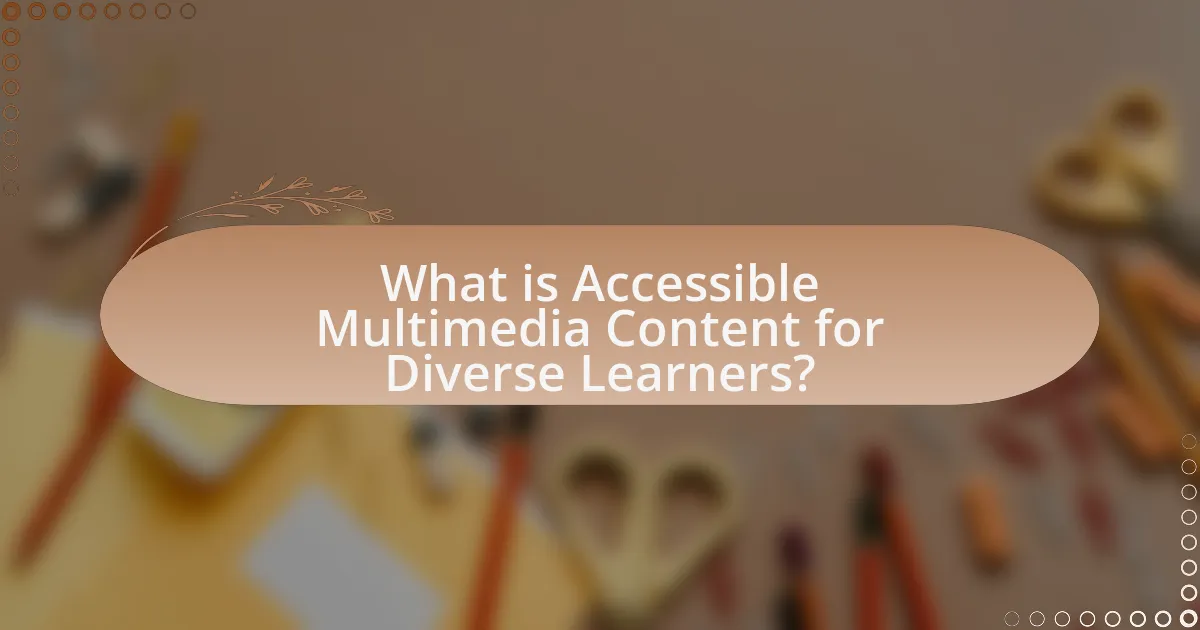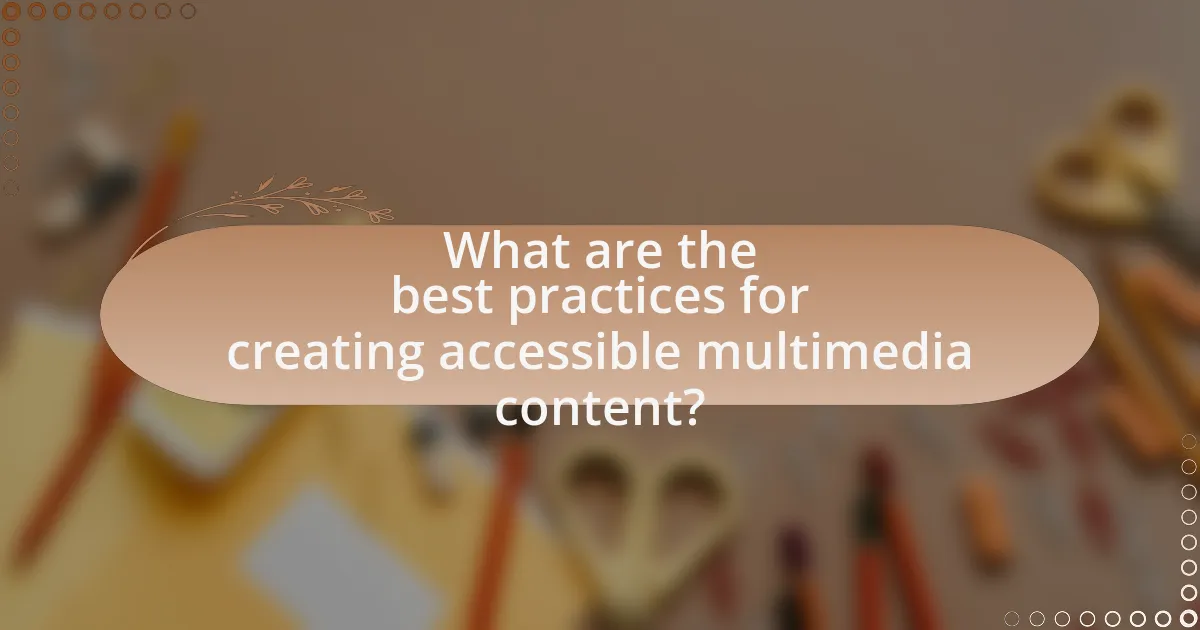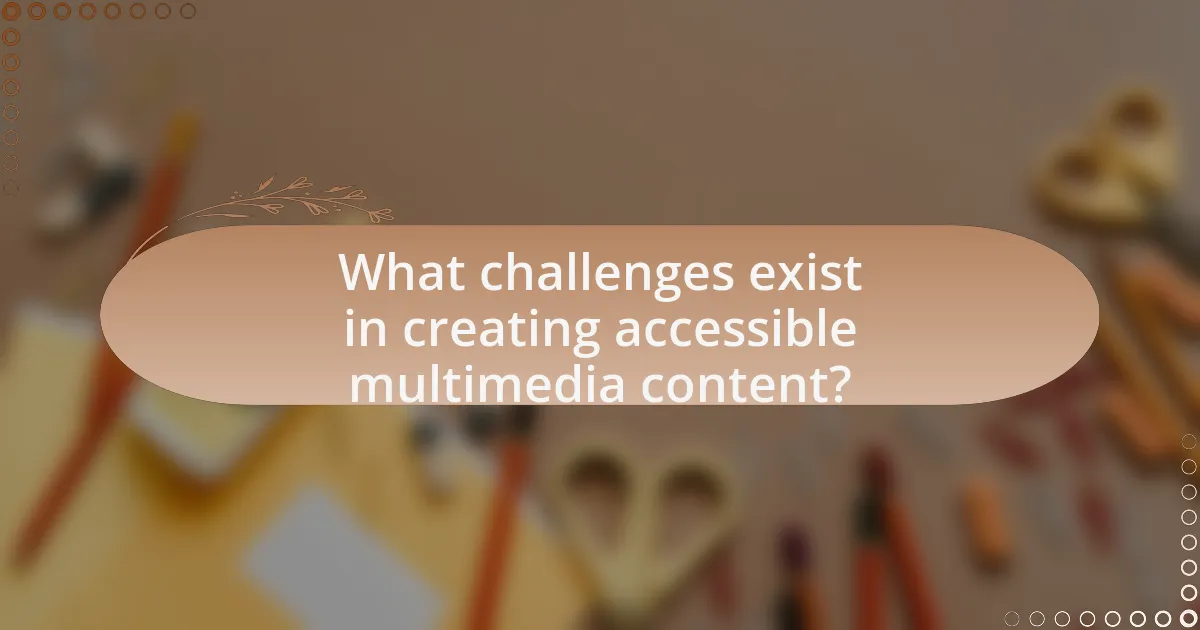Creating accessible multimedia content for diverse learners involves designing digital materials that accommodate individuals with varying abilities and learning preferences. This article outlines the importance of accessibility features such as captions, audio descriptions, and alternative text, which enhance comprehension for learners with disabilities. It discusses the key principles of accessibility, the benefits for diverse learners, and the legal and ethical considerations involved. Additionally, it addresses common challenges faced by content creators and offers practical strategies for improving accessibility practices, emphasizing the role of collaboration and the use of assistive technologies in fostering an inclusive educational environment.

What is Accessible Multimedia Content for Diverse Learners?
Accessible multimedia content for diverse learners refers to digital materials that are designed to be usable by individuals with varying abilities and learning preferences. This type of content includes features such as captions, audio descriptions, and alternative text, which enhance comprehension and engagement for learners with disabilities, such as visual or hearing impairments. Research indicates that approximately 15% of the global population experiences some form of disability, highlighting the necessity for inclusive educational resources. By implementing accessibility standards, such as the Web Content Accessibility Guidelines (WCAG), educators can ensure that multimedia content is effective for all learners, thereby promoting equity in education.
How does accessible multimedia content differ from traditional content?
Accessible multimedia content is designed to be usable by individuals with diverse abilities, while traditional content often lacks these considerations. Accessible multimedia incorporates features such as captions, audio descriptions, and alternative text, ensuring that people with visual or hearing impairments can engage with the material. In contrast, traditional content typically does not include these adaptations, which can exclude a significant portion of the audience. For instance, the World Health Organization estimates that over 1 billion people globally experience some form of disability, highlighting the importance of accessibility in multimedia content.
What are the key principles of accessibility in multimedia?
The key principles of accessibility in multimedia include perceivability, operability, understandability, and robustness. Perceivability ensures that all users can access content through various sensory modalities, such as providing text alternatives for non-text content. Operability guarantees that users can navigate and interact with multimedia using different input methods, including keyboard navigation. Understandability focuses on making content clear and easy to comprehend, which can involve using simple language and consistent layouts. Robustness ensures that multimedia content is compatible with a wide range of assistive technologies, allowing for future adaptability. These principles align with the Web Content Accessibility Guidelines (WCAG), which provide a framework for creating accessible digital content.
How do diverse learners benefit from accessible multimedia content?
Diverse learners benefit from accessible multimedia content by gaining improved engagement and comprehension through varied formats that cater to different learning styles. Accessible multimedia, such as videos, audio, and interactive elements, allows learners with varying abilities, including those with visual or auditory impairments, to access information in a way that suits their needs. Research indicates that using multiple modalities enhances retention and understanding; for instance, a study by Mayer (2009) found that students learn better when information is presented both visually and verbally. This approach not only supports learners with disabilities but also benefits all students by providing multiple pathways to understanding complex concepts.
Why is creating accessible multimedia content important?
Creating accessible multimedia content is important because it ensures that all individuals, regardless of their abilities or disabilities, can engage with and benefit from the information presented. Accessibility in multimedia allows people with visual, auditory, or cognitive impairments to access content through features like captions, audio descriptions, and alternative text. According to the World Health Organization, over 1 billion people globally experience some form of disability, highlighting the necessity for inclusive design. By creating accessible content, educators and content creators promote equal opportunities for learning and participation, fostering an inclusive environment that benefits everyone.
What legal and ethical considerations are involved?
Legal and ethical considerations in creating accessible multimedia content for diverse learners include compliance with laws such as the Americans with Disabilities Act (ADA) and Section 508 of the Rehabilitation Act, which mandate accessibility standards for educational materials. These laws require that content be usable by individuals with disabilities, ensuring equal access to information and learning opportunities. Ethical considerations involve the responsibility to provide equitable access to education, recognizing the diverse needs of learners, and promoting inclusivity. Failure to adhere to these legal and ethical standards can result in legal repercussions and hinder the educational experience for individuals with disabilities.
How does accessibility impact learning outcomes for diverse learners?
Accessibility significantly enhances learning outcomes for diverse learners by ensuring that educational materials are usable by individuals with varying abilities and needs. When learning environments are designed with accessibility in mind, they accommodate different learning styles and disabilities, leading to improved engagement and comprehension. Research indicates that accessible content, such as captions for videos and screen reader compatibility, can increase retention rates by up to 60% among students with disabilities. Furthermore, the National Center on Universal Design for Learning emphasizes that inclusive practices not only benefit learners with disabilities but also enhance the overall learning experience for all students, fostering a more equitable educational landscape.

What are the best practices for creating accessible multimedia content?
The best practices for creating accessible multimedia content include providing captions and transcripts for audio and video, ensuring color contrast for visual elements, and using descriptive audio for visual content. Captions and transcripts enhance comprehension for individuals with hearing impairments, as studies show that 1 in 5 people in the U.S. experience hearing loss. Ensuring sufficient color contrast helps individuals with visual impairments distinguish content, as poor contrast can hinder readability. Descriptive audio assists those with visual impairments by conveying essential visual information, improving their understanding of the multimedia experience. These practices align with the Web Content Accessibility Guidelines (WCAG), which provide a framework for making digital content accessible to all users.
How can multimedia elements be designed for accessibility?
Multimedia elements can be designed for accessibility by incorporating features such as captions, audio descriptions, and keyboard navigation. Captions provide text representation of spoken content, making videos accessible to individuals with hearing impairments. Audio descriptions offer verbal narration of visual elements, aiding those with visual impairments in understanding the content. Additionally, ensuring that all interactive elements are navigable via keyboard enhances usability for individuals who cannot use a mouse. Research indicates that implementing these features significantly improves accessibility, as evidenced by the Web Content Accessibility Guidelines (WCAG), which outline best practices for creating inclusive digital content.
What role do captions and transcripts play in accessibility?
Captions and transcripts are essential for enhancing accessibility by providing text alternatives for audio and visual content. They enable individuals with hearing impairments to understand spoken dialogue and sound cues, while also assisting non-native speakers and those with cognitive disabilities in comprehending the material. Research indicates that approximately 15% of the global population experiences some form of hearing loss, highlighting the necessity of captions and transcripts in making content inclusive. Furthermore, studies show that captions can improve comprehension and retention for all learners, not just those with disabilities, thereby reinforcing their role in creating accessible multimedia content for diverse audiences.
How can color contrast and font choices enhance accessibility?
Color contrast and font choices significantly enhance accessibility by improving readability for individuals with visual impairments and cognitive disabilities. High color contrast between text and background ensures that content is easily distinguishable, which is crucial for users with low vision or color blindness. For instance, the Web Content Accessibility Guidelines (WCAG) recommend a contrast ratio of at least 4.5:1 for normal text to ensure legibility. Additionally, selecting clear, sans-serif fonts with appropriate size and spacing can reduce cognitive load, making it easier for all users to process information. Research indicates that using larger font sizes and simple typefaces can improve comprehension and retention, particularly for learners with dyslexia. Thus, thoughtful color contrast and font selection are essential components in creating accessible multimedia content for diverse learners.
What tools and technologies can assist in creating accessible content?
Tools and technologies that assist in creating accessible content include screen readers, captioning software, and accessibility checkers. Screen readers, such as JAWS and NVDA, convert text to speech, enabling visually impaired users to access content. Captioning software like Amara and YouTube’s automatic captions provide text alternatives for audio content, enhancing accessibility for deaf or hard-of-hearing individuals. Accessibility checkers, such as WAVE and Axe, evaluate web content for compliance with accessibility standards like WCAG, ensuring that digital materials are usable for all learners. These tools collectively enhance the inclusivity of multimedia content for diverse learners.
Which software options are available for creating accessible multimedia?
Software options available for creating accessible multimedia include Adobe Captivate, Camtasia, and Microsoft PowerPoint. Adobe Captivate allows users to create e-learning content with features that support accessibility, such as screen reader compatibility and keyboard navigation. Camtasia provides tools for adding captions and annotations, enhancing the accessibility of video content. Microsoft PowerPoint includes accessibility checkers and options for alt text, making it easier to create presentations that are accessible to all learners. These software solutions are widely recognized for their capabilities in producing multimedia that meets accessibility standards.
How can assistive technologies support diverse learners?
Assistive technologies support diverse learners by providing tailored tools that enhance accessibility and engagement in educational settings. These technologies, such as screen readers, speech-to-text software, and adaptive devices, enable learners with disabilities to access content in ways that suit their individual needs. For instance, a study published in the “Journal of Special Education Technology” found that the use of assistive technologies significantly improved academic performance and participation among students with learning disabilities. By facilitating personalized learning experiences, assistive technologies empower diverse learners to overcome barriers and achieve their educational goals.

What challenges exist in creating accessible multimedia content?
Creating accessible multimedia content faces several challenges, including technical limitations, lack of awareness, and diverse user needs. Technical limitations arise from the need for specialized tools and software that can accommodate various accessibility features, such as captions, audio descriptions, and screen reader compatibility. Lack of awareness among content creators about accessibility standards, such as the Web Content Accessibility Guidelines (WCAG), often leads to non-compliance and exclusion of users with disabilities. Additionally, diverse user needs complicate the design process, as creators must consider varying disabilities, cultural contexts, and learning preferences, making it difficult to create universally accessible content.
What common barriers do content creators face?
Content creators face several common barriers, including limited resources, lack of technical skills, and difficulties in understanding diverse audience needs. Limited resources, such as time and funding, hinder the ability to produce high-quality content consistently. Additionally, many creators lack the technical skills necessary to utilize advanced tools and platforms effectively, which can restrict their creative potential. Understanding the diverse needs of audiences is also challenging, as creators must consider various accessibility requirements, which can complicate the content creation process. These barriers are well-documented in studies highlighting the struggles of creators in adapting content for inclusivity and engagement.
How can time and resource constraints affect accessibility efforts?
Time and resource constraints significantly hinder accessibility efforts by limiting the ability to implement necessary adaptations and modifications. When organizations face tight deadlines or budget restrictions, they often prioritize immediate deliverables over comprehensive accessibility features, resulting in content that may not meet the needs of all learners. For instance, a study by the National Center on Accessible Educational Materials found that 70% of educators reported that lack of time and funding directly impacted their ability to create accessible materials. This indicates that without adequate resources, the quality and inclusivity of educational content can suffer, ultimately affecting diverse learners’ engagement and success.
What misconceptions about accessibility hinder content creation?
Misconceptions about accessibility that hinder content creation include the belief that accessibility is solely about compliance with legal standards, that it only benefits individuals with disabilities, and that it requires extensive resources or technical expertise. These misconceptions can lead to a lack of prioritization in making content accessible, as creators may think it is an optional add-on rather than an integral part of the design process. For instance, a study by the World Health Organization indicates that over 1 billion people experience some form of disability, highlighting the broad impact of accessibility on diverse audiences. Additionally, accessible design often enhances user experience for all users, not just those with disabilities, as evidenced by the fact that features like captions and alt text improve content engagement universally.
How can these challenges be overcome?
To overcome the challenges of creating accessible multimedia content for diverse learners, developers should implement universal design principles and utilize assistive technologies. Universal design principles ensure that content is usable by all individuals, regardless of their abilities, by incorporating features such as captions, audio descriptions, and adaptable interfaces. Research indicates that applying these principles can significantly enhance accessibility; for instance, a study by the National Center on Accessible Educational Materials found that 80% of students with disabilities reported improved learning outcomes when multimedia content was designed with accessibility in mind. Additionally, leveraging assistive technologies, such as screen readers and alternative input devices, can further facilitate access for learners with specific needs, ensuring that all students can engage with the content effectively.
What strategies can be implemented to improve accessibility practices?
To improve accessibility practices, organizations should implement strategies such as adopting the Web Content Accessibility Guidelines (WCAG), conducting regular accessibility audits, and providing training for staff on inclusive design principles. Adhering to WCAG ensures that digital content is perceivable, operable, understandable, and robust for all users, including those with disabilities. Regular audits help identify and rectify accessibility barriers, while staff training fosters a culture of inclusivity and awareness. Research indicates that organizations that prioritize accessibility not only comply with legal standards but also enhance user experience and engagement, leading to broader audience reach and satisfaction.
How can collaboration with diverse learners enhance content accessibility?
Collaboration with diverse learners enhances content accessibility by integrating varied perspectives and learning styles, which leads to the development of more inclusive materials. When learners from different backgrounds work together, they share unique insights that can identify barriers in content comprehension and usability. Research indicates that diverse teams are more innovative; for instance, a study by Page (2007) in “The Difference: How the Power of Diversity Creates Better Groups, Firms, Schools, and Societies” shows that diversity improves problem-solving capabilities. This collaborative approach ensures that multimedia content is designed to meet the needs of all learners, making it more effective and accessible.
What are some practical tips for ensuring accessibility in multimedia content?
To ensure accessibility in multimedia content, incorporate captions and transcripts for audio and video elements. Captions provide a text representation of spoken dialogue, which aids individuals who are deaf or hard of hearing, while transcripts offer a complete text version of audio content, benefiting users with various disabilities. Additionally, use descriptive audio for visual elements, allowing blind or visually impaired users to understand the context. Implementing color contrast guidelines enhances readability for users with visual impairments, and ensuring that all interactive elements are keyboard navigable supports users with mobility challenges. These practices align with the Web Content Accessibility Guidelines (WCAG), which emphasize the importance of making content perceivable, operable, and understandable for all users.